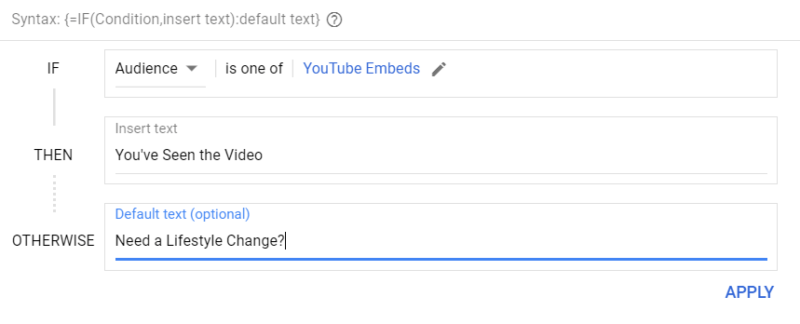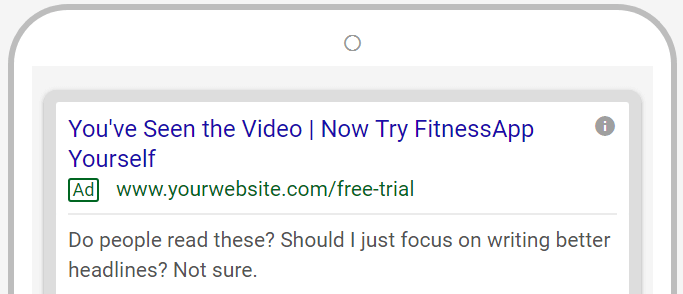In my last post for Search Engine Land about business data feeds, I went over how I used ad customizers to implement value-focused ad copy. I now want to show you another favorite ad customizer I think is underutilized. I am talking about IF functions.
IF functions are another way pay-per-click (PPC) marketers can create unique ads that are hard for the competition to replicate. I use business data feeds to call out extra benefits and value statements. With IF functions, I like to use the ad customizer to change my voice depending on what audiences I’m going after. Let me show you what IF functions are, how to set them up, and a few strategies I’m currently using on clients.
Where do we begin with IF Functions?
Start by creating a new expanded text ad in any one of your ad groups. The process for kicking off an ad customizer is the same across the board. Start your headline with an opening curly bracket or ‘ { .’
Select the “IF function” option, as seen in the image below, to get started.

Once we’re in the IF function portion of the ad creation, you’re going to see this view within Google Ads (formerly AdWords).

The IF function screen defaults to Device, and mobile is the device option. So in this scenario, I’m creating a Google Ad that allows me to give a different headline depending on what device the user is on.
For my mobile users, I might want a headline which says, “Quick Order from Your Phone.” Then, for everyone else not on a mobile device, I can possibly show them a headline like “Order in Just 3 Steps.”
Here’s what the setup would look like in Google Ads.

Within one ad, I can change my voice to speak differently to two different audiences. The IF functions allow me to change my ad message without having to create a ton of different campaigns or ad groups. The best part about IF functions is that we can do more than just device segmentation. We can change the IF option to “Audiences” to allow us to change the ad message for any search remarketing audience we have created in Google Ads or Google Analytics. Here’s one example we’re going to break down really soon.

Remarketing lists for search ad (RLSA) audiences need at least 1,000 users from the past 30 days. If you have audiences that large, start testing them in IF function ads to speak differently to your users or viewers.
One more added bonus: IF functions allow advertisers to avoid over-segmenting audiences in so many different ad groups, while still creating ad copy that is effective in making a personal connection.
A different strategy using IF functions?
Here’s a real-life example of a different strategy using IF functions.
I have a client that hosts a lot of video clips from their YouTube channel on their site. We’re using the YouTube Video Trigger from Simo Ahava to record all viewer interactions with the videos embedded on the site. With Google Analytics, I can create audiences based off of any Event Category, Action or Label. I created an audience based off of any viewer who watched a video on my client’s website, and with IF functions, we can change our messages
Now that you know the background, let’s go into the strategy. Using IF functions, I created one ad that spoke to the audiences that went to the site and watched a video and one for people who had not seen one of the videos.
The ad for users who have been to the site and watched a video could look like this:

See how I change my voice based on the actions the user took? If the viewer comes back to Google and searches for my client’s brand name, I want to speak as directly to that user as possible. I know they’ve watched a video, so I’m going to remind them of that action.
“You’ve seen the video. Now try my FitnessApp yourself.”
I made a connection with an audience I deemed valuable and then pushed for action. Now, what about users in the other audience, the people who have not seen the video? I might show them an ad like this one:

This ad is the “Otherwise” option of the IF function. If the user isn’t a part of my “video views” audience, they’ll see a headline that is broader in approach. I don’t know if the default audience has seen a video from my brand yet, so I want a softer sell that plants a seed.
“Need a lifestyle change? Give FitnessApp a try.”
Within the same ad, I’m speaking to two different audiences and changing how I talk to each user group depending on where they might be in my funnel.
I know you’re pumped to try these out, right? Well, hang on…
An IF downer
If you’re excited to try IF functions in your ads, I need to poke a hole in your happy balloon.
When Google announced at the Marketing Live event that responsive search ads were going to be rolling out to more users, I finally got to test something new! Right off the bat, I wanted to see what sort of ad customizers I could utilize with the new format. I thought with three headlines, I could customize my ads to another level!
Boy, my balloon deflated quickly.

When I added my opening curly bracket to the first headline, what did I see? Exactly what you see in the image above — dynamic keyword insertion. That’s the only option.
Unfortunately, IF functions and any other ad customizers are not available in responsive search ads right now.
While that’s disappointing, this doesn’t mean we should stop using IF functions. Expanded text ads are still going to be around for awhile. Keep testing out new expanded text ads (ETAs) to better speak to your target audience in your current campaigns and ad groups. Continue to utilize the custom targeting as long as possible while we all hope Google Ads brings the feature to responsive search ads, too.
Get started with IF functions
You probably have several remarketing audiences created in your Google Ads accounts. Take a look at all of the audiences you created and think about how you want to speak to each of those users. Remember, you don’t have to create a ton of different campaigns and ad groups to speak to each audience. Once you figure out what previous visitors, viewers or customers have already experienced, you can serve them the best ads to keep them moving along in the buyer’s journey.
Contributing authors are invited to create content for Search Engine Land and are chosen for their expertise and contribution to the search community. Our contributors work under the oversight of the editorial staff and contributions are checked for quality and relevance to our readers. The opinions they express are their own.




